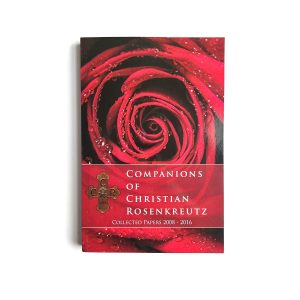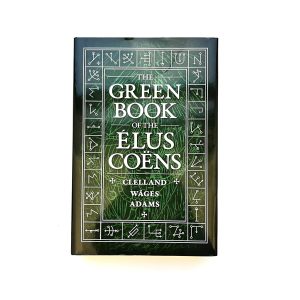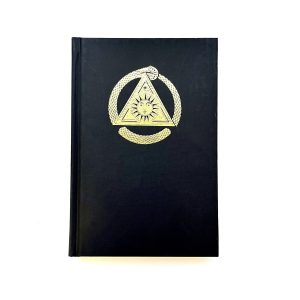A Stranger in the Elemental Temple: The Rituals of the Ancient Order of Ishmael
The Ancient Oriental Order of Ishmael, a para-Masonic system of thirty-six degrees, has a documented history and a unique ritual that has never been published. This book will include a brief biography of the four known heads of the Order, and a complete set of rituals. The rituals include the opening, closing, all thirty-six degrees, and the banquet toasts of the Order. Each degree includes an illustration of the jewel for the degree, with numerous illustrations and photographs to show other regalia and materials used to explain the degrees. An appendix documents letters between the members and the development and growth of the Order. 376 pages Hardback
Cagliostro The Unknown Master
First published in French in 1912, this detailed and extensively referenced biography of one of history's most enigmatic figures has the advantage of having been written by one of the early twentieth century's leading esotericists, Dr. Marc Haven (real name Dr. Emmanuel Lalande). Born in Lorraine in 1868, and trained as a medical doctor at the University of Paris, Haven (a close associate of the legendary Papus) brought all his scientific training and esoteric knowledge to bear on the mass of source material - often confused, sometimes contradictory, sometimes scurrilous, almost always hostile - which had accumulated around a man who, at various times and places, was described as a thief, an impostor, a philanderer and a charlatan. The Cagliostro that emerges from these pages - deeply moral, courageous, witty, lovable, a healer of unparalleled talent, a skillful alchemist, an early champion of women's rights, a reformer of Freemasonry and, above all, a true Christian - is far removed from the absurd diamond-encrusted charlatan of fiction and film. Haven's meticulous analysis of the writings of those who knew the man on a day-to-day basis and his willingness to let him speak for himself in his own noble and powerful words, restore him to his rightful place as one of the truly great figures of Western esotericism as well as a man who, had he succeeded in two of his major projects - preventing the French Revolution and persuading the Roman Catholic church to embrace his Egyptian Rite - would have changed the course of history. By turns hilarious and deeply moving, Haven's book remains, despite its age, one of the most colourful and comprehensive sources of information about this enigmatic figure as well as one of the finest esoteric biographies ever written. Paul Ferguson's translation of Haven's revised and corrected text is enriched with a short biography of the author, prefaces by 'Secret History of the World' author Jonathan Black and leading occult writer and Cagliostro expert Philippa Faulks, and a list of English-language Internet sources. Anyone with an interest in 18th century social and cultural history will enjoy this book, as well as esotericists, Rosicrucians, Freemasons and anyone concerned to see one of history's most maligned figures portrayed in his true light. Paperback 81 Printed Pages
Companions of Christian Rosenkreutz
A collection of stunning papers from great Rosicrucian scholars. For deep thinkers with an interest in hidden mysteries, this book really is a gem. Contained within are specialist articles containing rare knowledge on a vast variety of subjects presented together for the first time. Just some of the exciting subjects you will discover in the volume: What was the intention of the original Rosicrucian manifestos? Read a potted guide to the oriental mystery of Qi. An exploration the history of man's quest for powerful knowledge. The secret Buddhist scheme of creation and its relation to the Kabbalah The four ancients and the tradition of mastery of the four elements. Why did Christian Rosenkreutz go to Damcar in Arabia and what did he learn there? What was the first diagram of the Kabbalistic tree and how did this evolve? From Master Mason to Rosicrucian Adept. How does one level of mastery lead to the next?
The Green Book of The Elus Coens
Select options
This product has multiple variants. The options may be chosen on the product page
The Life and Death of John Yarker
John Yarker was a Victorian Occultist, Freemason and esoteric Truth Seeker, who is now somewhat revered by both esoteric Freemasons and Occultists alike. He was born in Cumbria, but moved to Manchester, where he spent the rest of his life, and authored countless articles, short papers, and books that now fetch large sums at book auctions. He also collected together a number of Masonic and Oriental Orders, and he was said to have been the lynchpin for the founding of the O.T.O., a move that secured his Occult status. Indeed, Yarker was a strong influence on Aleister Crowley, introducing him to the Ancient and Primitive Rite. This work is the first extensive biography written of John Yarker's life, and explores his early life, his Masonic career, and his eclectic collection of Rites and Orders, which include the Society of Eight, the Sat B'hai, the Swedenborgian Rite, the Ancient and Primitive Rite, Martinism and the Adoptive Rite, to name but a few. The book also presents an examination of his extensive works, and looks at his legacy, focusing especially upon his collection of Rites and Orders, some of which survive today and are still practiced. The work highlights documents and letters from Yarker that have never before been published, including letters that chart the early beginnings of the Operatives and the O.T.O. The work also presents a deep insight into Yarker's life and legacy, especially examining how Yarker is still celebrated in certain esoteric lineages that exist today. Highlights include: Yarker's Orders, Societies and Rites include the Society of Eight, Sat B'hai, the Swedenborgian Rite, the Celestial Brotherhood, the Ancient and Primitive Rite, Martinism and the Adoptive Rite, to name but a few. Includes documents and letters never before been published and an extensive list of Yarkers known works. Discover Yarker's key role in the founding of the Order of the Operatives. Learn about the mysterious order of the Sat B'hai, an Order that, like the Hermetic Brothers of Egypt, was inspired by the fashionable Orientalism of the period. Explore the PanSophic Rites, which celebrate a connection to Yarker through a lineage of Orders. Find out all about the Order of Zuzamites, whose members included some of the first Muslim converts in England. The leader of the Order was actually the man who opened the first Mosque in the UK.
The Origins and History of the Order of Free Gardeners
Freemasonry only had one serious competitor and that was from Free Gardenery. Both came from the same roots, the former from the trade of stonemasonry and the latter, that of gardening. It was anticipated that membership of Lodges would be drawn from men working in those trades. But from the outset Free Gardeners initiated men who were not gardeners and this was specifically catered for in their first written rules of the order. What attracted these gentlemen gardeners to seeks admission to a Lodge is not clear but perhaps the elaborate rituals, regalia and practical advice cannot be ruled out. The parallels between Free Gardenery and Freemasonry were remarkably similarity to Freemasonry in that both were created by operative Scottish gardeners and stonemasons respectively. A comparison between the two orders, their origins and development provides an unusual dimension for the study of both. This book provides the reader and fantastic introduction to the fraternity of Free Gardeners outlining its history, showing its regalia and describing its degrees. 152 Pages, ISBN 978 0 85318 656 4 Highly Illustrated Hardback
The Rite of Seven Degrees
This book examines the deeply esoteric eighteenth-century Rite of Seven Degrees. This Masonic Rite was practised in London but led by French engraver and ex-soldier Pierre Lambert de Lintot. This work not only presents the story of de Lintot and his Rite, but for the first time displays the rituals and the order’s minute book fully translated from the late eighteenth century French into English, which not only reveals the workings of the lost Rite but adds to our historical understanding of the development of high degree rituals in a wider context. Highlights: Discover a system that evolved during a short period of Masonic experimentation that witnessed four Grand Lodges operating in England Explore the mysterious engravings of de Lintot, which acts as a window into his Masonic world and shows how Masonic rituals in higher orders that are still practiced today were interpreted at the time. Learn more about key Masonic figures of the time such as Cagliostro, Ruspini and William Preston, who also feature in previous books in the Lost Rites series; Rediscovered Rituals of English Freemasonry & Lost Rites and Rituals of Freemasonry. Discover the other colourful characters in the circle of de Lintot who shed light on Freemasonry's place in the vibrant London scene that entwined Masonic themes and new ideas during the Age of Enlightenment. Delve into the relationship of the Rite of Seven Degrees with other seven degree orders such as the Rite of Clermont and the Baldwyn Rite, which is still practiced today in Bristol.













